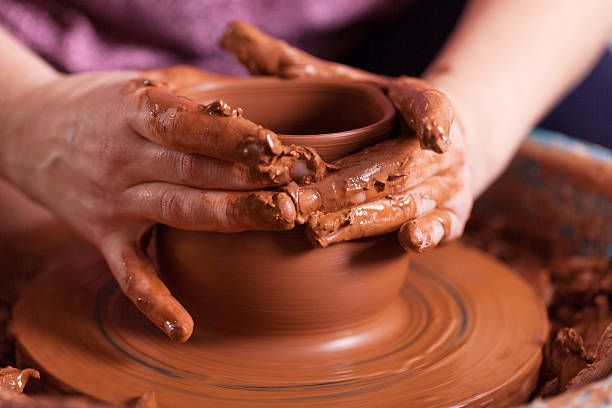What Is The Art Of Making Containers Out Of Clay Called?
The art of making containers, tableware, ornaments, and other objects out of clay is called pottery or ceramics. Evidence of pottery dates back over 20,000 years, making it one of the oldest human inventions and art forms.
The earliest known ceramic objects were made in East Asia and date to 20,000 to 10,000 years ago, around the end of the last Ice Age. As early humans began settling into agricultural societies, pottery emerged as a useful craft for storing, transporting, and cooking food. Over time, pottery techniques and styles diversified around the world. Early civilizations in Mesopotamia, Egypt, Greece, Rome, China, and the Americas all developed their own unique pottery traditions.
While the earliest pottery was made by hand, most modern pottery is produced on a wheel. Clay is shaped into vessels or sculptures and then hardened through firing in a kiln. glazes and decorations can be applied before or after firing to color and embellish the clay. From functional bowls to decorative vases, pottery artifacts provide archaeologists insights into the lifestyles and values of ancient cultures.
Today, pottery remains a popular craft and art form. Both practical and decorative ceramics are created worldwide using ancient techniques as well as modern technologies and influences.
Tools and Materials
The most essential tools and materials needed for making pottery are clay, a potter’s wheel, kiln, and various hand tools. The type of clay used depends on the desired outcome, with stoneware and porcelain clays being most common for functional pottery due to their durability when fired at high temperatures. According to Best Pottery Tools and Equipment (https://www.sliceproducts.com/pages/best-pottery-tools), basic hand tools include bladed tools like pottery knives for cutting and smoothing, as well as ribs, scrapers, and loop tools for shaping. Having an apron, chamois, and potter’s needles for surface detailing is also recommended. A potter’s wheel allows for symmetrical shaping, while the kiln fires and hardens the clay at temperatures usually between 2,000°F to 2,300°F.
Other useful pottery tools noted by Garrity Pottery Tools Made in the USA (https://www.sheffield-pottery.com/Garrity-Pottery-Tools-s/980.htm) include calipers for precise measuring, cut-off wires for cleanly cutting clay from the wheel, small handheld paddles, and specialized modeling tools like loop tools and ribbon tools. Fettling knives help trim excess clay from fired pieces. Having a variety of different tools allows potters to achieve more intricate and detailed pieces. Overall, clay, a wheel, kiln, and an assortment of hand tools form the foundation of a pottery studio.
Shaping Methods
There are several techniques used to shape clay into pottery. The most common methods are throwing, handbuilding, and casting in molds.
Throwing involves using a potter’s wheel to form vessels. A lump of clay is centered on the wheel and then pushed, pulled, and shaped by the potter’s hands as the wheel spins. Throwing allows creating symmetrical rounded forms quickly.

Handbuilding involves directly manipulating the clay into shape without the use of a wheel. Techniques like pinch pots, coiling, and slab building are common handbuilding methods. Handbuilding allows creating asymmetrical and intricately shaped forms.
Molding involves pressing soft clay into or over a shaped mold to create the desired form. The clay is then removed from the mold after drying and fired. Casting in molds allows efficient replicating of shapes and intricate detailing.
As explained in the articles Identifying Ceramic Shaping Techniques and Fine pottery shaping techniques in Predynastic Egypt, potters combine these techniques to create unique styles and forms of pottery.
Decoration
Decorating pottery is an important step in creating beautiful and functional pieces of pottery. There are many techniques that can be used to decorate the bare clay surface before or after firing. Some common decoration methods include:
Glazing – Glazes are glass-like coatings applied to bisqueware and fired in a kiln. Glazes come in endless colors and textures and serve both decorative and functional purposes like making pieces waterproof. Popular glaze techniques include brushing, dipping, pouring, and spraying.
Underglazes – Underglazes are pigments applied to raw or bisque pottery that become permanent when fired under a transparent glaze. Underglazes allow for colorful decoration with the functional benefits of a glaze overlay.
Painting – Pottery paints like underglazes can be applied to raw or bisque clay and become permanent during firing. Acrylic and oil-based paints can also be used on finished pottery. Painting allows for freeform decorative techniques.
Textures – Interesting textures can be created on clay using techniques like carving, impressing objects, or applying slip trailing, by layering liquid clay onto the surface. Textures add visual interest and dimension.
Stenciling – Using stencils and sponges to apply underglazes, glazes or slips allows for repeated imagery and patterns. Stencils can create complex designs with simplicity.
The options for decorating pottery are endless. Imagination and experimentation with different materials and techniques allow potters to add beautiful, colorful, and textured embellishments to their work.
Firing
Firing is a crucial step in the pottery-making process. After shaping and decorating the clay, the pottery must be fired in a kiln to permanently set the clay and finish the ceramic piece.
There are two main stages of firing: bisque firing and glaze firing. Bisque firing is done after the clay has fully dried to drive out any remaining moisture and chemically transform the clay into a ceramic material. According to The Pottery Wheel, bisque firing usually occurs between 1452-1832°F (790-1000°C) [1]. This initial bisque firing prepares the pottery to then receive a glaze coating.
After bisque firing, the pottery is glazed or painted and then fired again at an even higher temperature, typically between 2012-2372°F (1100-1300°C). This glaze firing melts the glaze so that it vitrifies and fuses with the bisque ware body to create a glossy surface and complete the pottery piece [2]. Glaze firing allows pottery to become impervious to liquids and fully functional as dinnerware, vases, or other ceramic items.
Forms and Uses
Native American potters crafted vessels in a variety of forms and for numerous functional uses. Some of the most common vessels included jars, bowls, plates, bottles, and pots used for cooking, serving, and storage. Large storage jars were often used to hold grains, seeds, nuts, and other foods.
Bowls were made in many sizes and used for individual eating as well as serving communal meals. Plates were also important for eating. Potters created specialized vessels like bottles for holding liquids and pitchers for serving. Pots were essential for cooking over fire. Bean pots, with a small opening and wide bottom, were designed specifically for cooking beans and stews.
In addition to practical uses, vessels were made for ceremonial and ritual purposes. Elaborate bottles and head pots were crafted for burial practices. Effigy pots modeled into animal shapes held symbolic meaning. Native potters considered both functional needs and cultural traditions when forming their clay vessels.
Notable Styles of Pottery
Pottery has been crafted in Japan for centuries, and over time distinct regional styles emerged. Some of the most well-known styles include Satsuma ware, Raku ware, Bizen ware, Shigaraki ware, and Hirado ware. Satsuma ware originated on Kyushu island in the late 16th century and is known for its crackled glaze and elaborate decorations done in gold, red, and sometimes purple. Bizen ware comes from Okayama prefecture and dates back to the Kamakura period. It has a rustic, unglazed aesthetic. Shigaraki ware is a medieval style that incorporates sandy textures. Hirado ware comes from Nagasaki prefecture and features painted designs under a transparent glaze. Raku ware involves removing pottery from the kiln while still hot and placing it in materials that combust to create crackled effects.
In England, pottery styles like Staffordshire pottery and slipware emerged in the 17th century. Staffordshire pottery encompasses vibrant, affordable earthenware pottery with enamel decorations. Slipware involves trailing slip clay across the main clay body to create decorative patterns. These traditional English styles influenced potters in the American colonies as well.
Notable Potters
Throughout history, many ceramic artists have made significant contributions to the art of pottery. Here are some of the most influential potters over time:
In the early 20th century, Bernard Leach (https://www.pinterest.com/techlady51/famous-potters/) was instrumental in spreading pottery skills from East Asia to the West. Leach established the Leach Pottery in St Ives, England in 1920 and created a distinct style blending Western and Eastern ceramic traditions.
Shoji Hamada (https://www.pinterest.com/carlrcrutchfield/famous-potters-i-admire/) was a Japanese potter who studied and worked with Leach to create natural shapes and subtle earth tone glazes. He later founded his own pottery in Mashiko, Japan and mentored many potters.
Lucie Rie was an Austrian-British potter who escaped Nazi occupation in 1938 and settled in London. She became known for her abstract, modernist forms and luminous glazes on porcelain and stoneware.
Peter Voulkos was an American artist who pushed the boundaries of traditional pottery in the 1950s-60s. He pioneered abstract, sculptural forms and helped elevate pottery to fine art.
Other influential contemporary potters include Eva Zeisel, Ruth Duckworth, Karen Karnes, Toshiko Takaezu, and Marguerite Wildenhain who pioneered bold new directions in pottery.
Pottery Today
In today’s world, pottery is still very much alive as both an art form and a craft (Pottery today). While industrialization has allowed mass production of utilitarian pottery, there are many artisans keeping the tradition of handmade pottery alive (Mata Ortiz Pottery Today). Studios produce a wide variety of handcrafted pottery from mugs to vases to plates and more. Pottery as an art form is still widely practiced, with new styles and techniques constantly emerging. Many potters today blend modern and traditional techniques to create unique contemporary ceramic art. Pottery classes remain popular as both a creative outlet and way to connect with ancient crafts. While the popularity of handmade pottery has declined with industrialization, it is still treasured for its artistry, individuality, and human connection.
Conclusion
In summary, the art of making containers out of clay is called pottery or ceramics. It involves shaping clay using a variety of techniques, decorating the clay, and firing it in a kiln to harden it. Potters have created functional forms like bowls and vases as well as sculptural pieces throughout history across many cultures. Notable pottery styles range from ancient Greek Amphorae vessels to delicately painted porcelain from China. While the fundamentals of pottery have remained relatively consistent over time, today there is a thriving community of studio potters who are pushing the boundaries of what clay can create through both form and surface design. Though pottery was once vital for storage and transportation, it remains a beloved artform. The process of manipulating humble clay into beautiful and useful objects is an ancient human impulse that continues to inspire.


